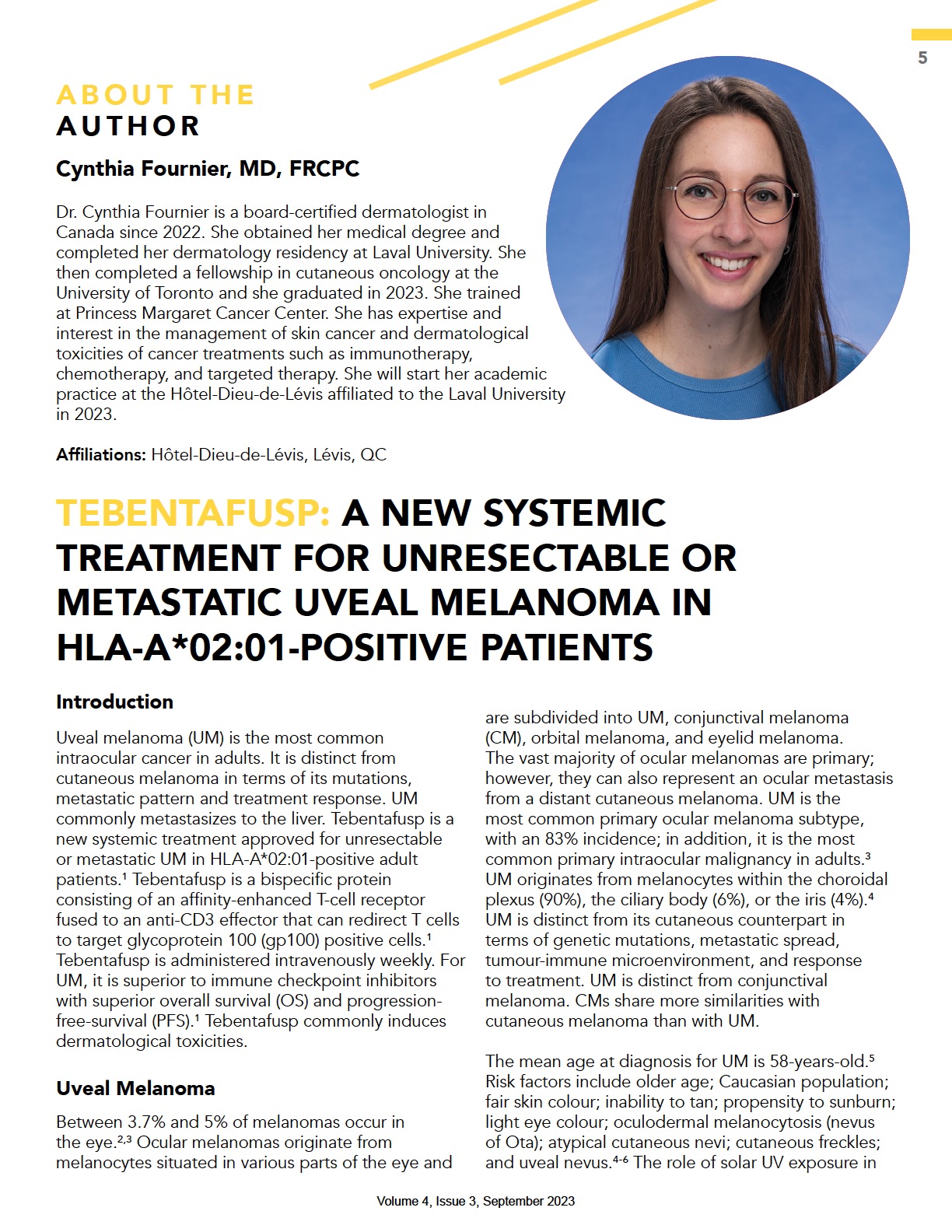Tebentafusp: A New Systemic Treatment for Unresectable or Metastatic Uveal Melanoma in HLA-A*02:01-positive patients
Abstract
Uveal melanoma (UM) is the most common intraocular cancer in adults. It is distinct from cutaneous melanoma in terms of its mutations, metastatic pattern and treatment response. UM commonly metastasizes to the liver. Tebentafusp is a new systemic treatment approved for unresectable or metastatic UM in HLA-A*02:01-positive adult patients. Tebentafusp is a bispecific protein consisting of an affinity-enhanced T-cell receptor fused to an anti-CD3 effector that can redirect T cells to target glycoprotein 100 (gp100) positive cells. Tebentafusp is administered intravenously weekly. For UM, it is superior to immune checkpoint inhibitors with superior overall survival (OS) and progression-free-survival (PFS). Tebentafusp commonly induces dermatological toxicities.
References
Nathan P, Hassel JC, Rutkowski P, et al. Overall survival benefit with tebentafusp in metastatic uveal melanoma. New England Journal of Medicine. 2021;385(13):1196-1206.
McLaughlin CC, Wu XC, Jemal A, Martin HJ, Roche LM, Chen VW. Incidence of noncutaneous melanomas in the U.S. Cancer. 2005;103(5):1000-1007.
Chang AE, Karnell LH, Menck HR. The National Cancer Data Base report on cutaneous and noncutaneous melanoma: a summary of 84,836 cases from the past decade. The American College of Surgeons Commission on Cancer and the American Cancer Society. Cancer. 1998 Oct 15;83(8):1664-78.
Kaliki S, Shields CL. Uveal melanoma: relatively rare but deadly cancer. Eye. 2016;31(2):241-257.
Jovanovic P, Mihajlovic M, Djordjevic-Jocic J, Vlajkovic S, Cekic S, Stefanovic V. Ocular melanoma: an overview of the current status. Int J Clin Exp Pathol. 2013 Jun 15;6(7):1230‑44.
Nayman T, Bostan C, Logan P, Burnier MN. Uveal melanoma risk factors: a systematic review of meta-analyses. Current eye research. 2017;42(8):1085-1093.
Vivian AJ, Ellison DW, McGill JI. Ocular melanomas in xeroderma pigmentosum. British Journal of Ophthalmology. 1993;77(9):597-598.
Van Raamsdonk CD, Bezrookove V, Green G, et al. Frequent somatic mutations of GNAQ in uveal melanoma and blue naevi. Nature. 2008;457(7229):599-602.
Van Raamsdonk CD, Griewank KG, Crosby MB, et al. Mutations in GNA11in uveal melanoma. New England Journal of Medicine. 2010;363(23):2191-2199.
Collaborative Ocular Melanoma Study Group. Assessment of metastatic disease status at death in 435 patients with large choroidal melanoma in the Collaborative Ocular Melanoma Study (COMS). Archives of Ophthalmology. 2001;119(5):670.
Khoja L, Atenafu EG, Suciu S, et al. Meta-analysis in metastatic uveal melanoma to determine progression free and overall survival benchmarks: an international rare cancers initiative (IRCI) ocular melanoma study. Annals of Oncology: Official Journal of the European Society for Medical Oncology. 2019;30(8):1370-1380.
Kujala E, Ma¨kitie T, Kivela¨ T. Very long-term prognosis of patients with malignant uveal melanoma. Investigative Ophthalmology & Visual Science. 2003;44(11):4651.
Rodriguez-Vidal C, Fernandez-Diaz D, Fernandez-Marta B, et al. Treatment of metastatic uveal melanoma: systematic review. Cancers. 2020;12(9):2557.
Hassel JC, Rutkowski P, Baurain J-F, Butler MO, Schlaak M, Sullivan R, et al. Co-primary endpoint of overall survival for tebentafusp (tebe)-induced rash in a phase 3 randomized trial comparing tebe versus investigator’s choice (IC) in first-line metastatic uveal melanoma. J Clin Oncol. 2021; 39: 9527.
Middleton MR, McAlpine C, Woodcock VK, Corrie P, Infante JR, Steven NM, et al. Tebentafusp, a TCR/anti-cd3 bispecific fusion protein targeting gp100, potently activated antitumor immune responses in patients with metastatic melanoma. Clin Cancer Res. 2020; 26(22):5869-78.
Pham J, Star P, Ardolino L, Smith A, Joshua AM. A review of the cutaneous toxicities of tebentafusp—featuring two cases involving superficial bullous reactions. Australas J Dermatol. 2022;63(3).
Lambertini M, Comito F, Melotti B, Baracca MF, Dika E. Drug-induced photosensitivity during tebentafusp treatment for metastatic uveal melanoma: A newly described occurrence. Journal of the European Academy of Dermatology and Venereology. 2022;37(2):e207-e208.
Orloff M, Sacco JJ, Nathan PC, et al. Abstract 3295: Vitiligo and other clinical melanocyte-related adverse events following tebentafusp (IMCgp100) exposure in patients with uveal melanoma. Cancer Research. 2020;80.


